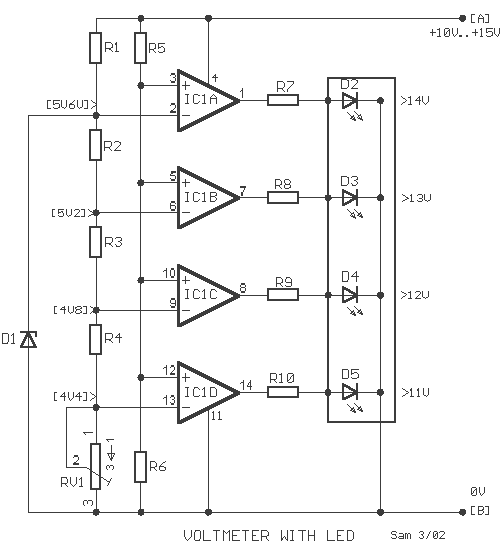
Voltmeter With LED For Car Battery

Below is a comparator circuit that can measure the voltage of a car battery in 1-volt steps. The voltage indication is achieved through a comparison mechanism.
The described comparator circuit is designed to accurately measure and indicate the voltage level of a car battery in increments of one volt. It utilizes a voltage comparator, which is a device that compares two input voltages and outputs a digital signal based on their relative magnitudes.
The circuit typically consists of a reference voltage source, which establishes the threshold levels for the comparison, and the car battery voltage is fed into one of the comparator's inputs. The other input is connected to the reference voltage, which can be set at intervals corresponding to the voltage levels of interest (e.g., 0V, 1V, 2V, etc.).
When the voltage from the car battery exceeds the reference voltage, the comparator outputs a high signal, indicating that the battery voltage is above the set threshold. Conversely, if the battery voltage is below the reference level, the output will be low. This output can be connected to an LED indicator or an LCD display to provide a visual representation of the battery voltage level.
For enhanced functionality, multiple comparators can be used in a ladder configuration to cover a wider voltage range. Each comparator can be set to a different reference voltage, allowing for a more granular indication of the battery's state. Additionally, hysteresis can be introduced into the circuit to prevent rapid toggling of the output due to minor fluctuations in battery voltage.
Power supply considerations are crucial for the comparator circuit; it should operate within the voltage rating of the components used, ensuring reliable performance. Furthermore, proper filtering and protection measures should be implemented to safeguard the circuit from voltage spikes or noise that may be present in automotive environments.
Overall, this comparator circuit serves as an effective solution for monitoring the voltage of a car battery, providing clear and immediate feedback on its state of charge.Below is a comparator circuit which is can measure with step of 1 volt, the voltage of car battery. The indication of voltage is done by comparison of? . 🔗 External reference
The described comparator circuit is designed to accurately measure and indicate the voltage level of a car battery in increments of one volt. It utilizes a voltage comparator, which is a device that compares two input voltages and outputs a digital signal based on their relative magnitudes.
The circuit typically consists of a reference voltage source, which establishes the threshold levels for the comparison, and the car battery voltage is fed into one of the comparator's inputs. The other input is connected to the reference voltage, which can be set at intervals corresponding to the voltage levels of interest (e.g., 0V, 1V, 2V, etc.).
When the voltage from the car battery exceeds the reference voltage, the comparator outputs a high signal, indicating that the battery voltage is above the set threshold. Conversely, if the battery voltage is below the reference level, the output will be low. This output can be connected to an LED indicator or an LCD display to provide a visual representation of the battery voltage level.
For enhanced functionality, multiple comparators can be used in a ladder configuration to cover a wider voltage range. Each comparator can be set to a different reference voltage, allowing for a more granular indication of the battery's state. Additionally, hysteresis can be introduced into the circuit to prevent rapid toggling of the output due to minor fluctuations in battery voltage.
Power supply considerations are crucial for the comparator circuit; it should operate within the voltage rating of the components used, ensuring reliable performance. Furthermore, proper filtering and protection measures should be implemented to safeguard the circuit from voltage spikes or noise that may be present in automotive environments.
Overall, this comparator circuit serves as an effective solution for monitoring the voltage of a car battery, providing clear and immediate feedback on its state of charge.Below is a comparator circuit which is can measure with step of 1 volt, the voltage of car battery. The indication of voltage is done by comparison of? . 🔗 External reference
